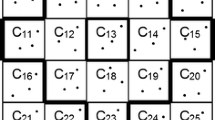Abstract
With the deep study of the Hamming distances of orthogonal arrays (OAs), the application of OAs has penetrated into many fields, one of which is to construct the key predistribution schemes (KPSs) for distributed sensor networks. In this paper, we define the Hamming distance distribution (HDD) of an OA and its uniqueness. Furthermore, we present some OAs with unique HDD. In KPSs based on these OAs, the calculations of metrics for evaluating connectivity and resilience can be simplified. We also illustrate that KPSs based on them have a wider application and better connectivity and resilience than the existing ones.
Similar content being viewed by others
References
Hedayat, A. S., Sloane, N. J. A., & Stufken, J. (1999). Orthogonal arrays: Theory and applications. New York: Springer.
Zhang, Y. S., Lu, Y. Q., & Pang, S. Q. (1999). Orthogonal arrays obtained by orthogonal decomposition of projection matrices. Statistica Sinica, 9(2), 595–604.
Delsarte, P. (1973). An algebraic approach to the association schemes of coding theory. Philips Research Laboratores (suppl.), No. 10.
Eschenauer, L., & Gligor, V. B. (2002). A key-management scheme for distributed sensor networks. In Proceedings of the 9th ACM conference on computer and communications security (pp. 41–47).
Chan, H., Perrig, A., & Song, D. (2003). Random key predistribution schemes for sensor networks. In IEEE symposium on research in security and privacy (pp. 197–213).
Çamtepe, S. A., & Yener, B. (2004). Combinatorial design of key distribution mechanisms for wireless sensor networks. In Proceedings of the European symposium on research computer security (pp. 293–308).
Paterson, M. B., & Stinson, D. R. (2014). A unified approach to combinatorial key predistribution schemes for sensor networks. Designs, Codes and Cryptography, 71(3), 433–457.
Martin, K. M. (2009). On the applicability of combinatorial designs to key predistribution for wireless sensor networks. Lecture Notes in Computer Science, 5557, 124–145.
Lee, J., & Stinson, D. R. (2005). A combinatorial approach to key predistribution schemes for distributed sensor networks. In WCNC 2005, IEEE wireless computing and networking conference (pp. 1200–1205).
Lee, J., & Stinson, D. R. (2006). Common intersection designs. Journal of Combinatorial Designs, 14(4), 251–269.
Lee, J., & Stinson, D. R. (2008). On the construction of practical key predistribution schemes for distributed sensor networks using combinatorial designs. ACM Transactions on Information and System Security 11(2), Article no. 5.
Ruj, S., & Roy, B. (2007). Key predistribution schemes using partially balanced designs in wireless sensor networks. Lecture Notes in Computer Science, 4742, 431–445.
Pang, S. Q., Yan, R., & Li, S. (2017). Schematic saturated orthogonal arrays obtained by using the contractive replacement method. Communications in Statistics-Theory and Methods, 46(18), 8913–8924.
Pang, S. Q., & Chen, L. Y. (2017). Generalized Latin matrix and construction of orthogonal arrays. Acta Mathematicae Applicatae Sinica, 33(4), 1083–1092.
Pang, S. Q., Xu, W. J., Chen, G. Z., & Wang, Y. (2018). Construction of symmetric and asymmetric orthogonal arrays of strength \(t\) from orthogonal partition. Indian Journal of Pure and Applied Mathematics, 49(4), 663–669.
Dong, J. W., Pei, D. Y., & Wang, X. L. (2008). A class of key predistribution schemes based on orthogonal arrays. Journal of Computer Science and Technology, 23(5), 825–831.
Gao, Q., Ma, W. P., & Li, X. P. (2017). A key predistribution scheme based on mixed-level orthogonal arrays. Ad Hoc & Sensor Wireless Networks, 37, 53–69.
Gao, Q., Ma, W. P., & Luo, W. (2018). Key predistribution schemes for wireless sensor networks based on combinations of orthogonal arrays. Ad Hoc Networks, 73, 40–50.
Pang, S. Q., Wang, X. N., Wang, J., Du, J., & Feng, M. (2018). Construction and count of 1-resilient rotation symmetric Boolean functions. Information Sciences, 450, 336–342.
Stinson, D. R. (2003). Combinatorial design: Constructions and analysis. New York: Springer.
Kendall, M., Kendall, E., & Kendall, W. S. (2012). A generalised formula for calculating the resilience of random key predistribution schemes. In IACR Cryptology Eprint Archive (p. 426).
Du, W., Deng, J., Han, Y. S., et al. (2005). A pairwise key predistribution scheme for wireless sensor networks. ACM Transactions on Information and System Security (TISSEC), 8(2), 228–258.
Bose, M., Dey, A., & Mukerjee, R. (2013). Key predistribution schemes for distributed sensor networks via block designs. Designs, Codes and Cryptography, 67(1), 111–136.
Dong, J. W., Pei, D. Y., & Wang, X. L. (2008). A key predistribution scheme based on 3-design. Lecture Notes in Computer Science, 4990, 81–92.
Pei, D. Y., Dong, J. W., & Rong, C. M. (2010). A novel key pre-distribution scheme for wireless distributed sensor networks. Science China Information Sciences, 53(2), 288–298.
Bush, K. A. (1952). Orthogonal arrays of index unity. The Annals of Mathematical Statistics, 23(3), 426–434.
Colbourn, C. J., & Dinitz, J. H. (2007). Handbook of combinatorial designs. Boca Raton: CRC Press.
Shrikhande, S. S. (1964). Generalized Hadamard matrices and orthogonal arrays of strength two. Canadian Journal of Mathematics, 16(4), 736–740.
Wang, J. C., & Wu, C. F. J. (1991). An approach for the construction of asymmetrical orthogonal arrays. Journal of the American Statistical Association, 6, 450–456.
Mukerjee, R., & Wu, C. F. J. (1995). On the existence of saturated and nearly saturated asymmetrical orthogonal arrays. The Annals of Statistics, 23(6), 2102–2115.
Zhang, Y. L. (2009). On schematic orthogonal arrays of strength two. ARS Combinatoria, 91, 147–163.
Hedayat, A. S., Seiden, E., & Stufken, J. (1997). On the maximal number of factors and the enumeration of 3-symbol orthogonal arrays of strength 3 and index 2. Journal of Statistical Planning and inference, 58, 43–63.
Acknowledgements
This work was supported by National Science Foundation of China under Grant Nos. 11571094 and 11971004.
Author information
Authors and Affiliations
Corresponding author
Additional information
Publisher's Note
Springer Nature remains neutral with regard to jurisdictional claims in published maps and institutional affiliations.
Rights and permissions
About this article
Cite this article
Pang, S., Li, Y., Gao, Q. et al. Key Predistribution Schemes Based on Orthogonal Arrays with Unique Hamming Distance Distribution. Wireless Pers Commun 112, 1919–1945 (2020). https://doi.org/10.1007/s11277-020-07133-4
Published:
Issue Date:
DOI: https://doi.org/10.1007/s11277-020-07133-4




